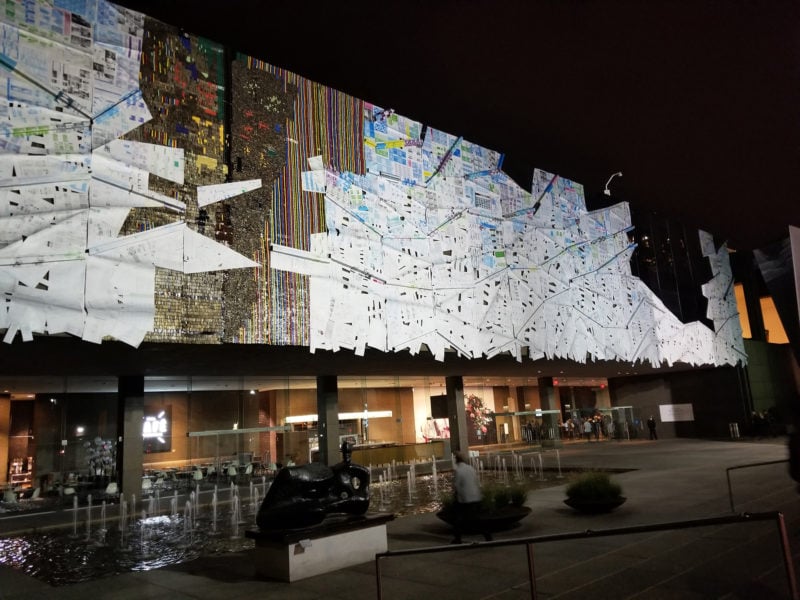The façade of the Carnegie Museum of Art (CMOA) in Pittsburgh is hardly recognizable. It’s cloaked in a 30-foot-high installation of wired-together bottle caps; reclaimed aluminum printing plates, arranged according to color in patches of red, blue, and yellow; and mirrored metal. This is the creation of Ghanaian artist El Anatsui, whose similar works of metal and bottle caps and copper wire have covered buildings including the El Badi Palace in Morocco.
Here, Anatsui was inspired by a specific day that he visited Pittsburgh in 2017. It was cold, grey, and drizzling, and he was struck by how the rain had transformed a Richard Serra sculpture in front of the museum. The wetness seemed to merge with the very material of the sculpture itself. Now his “Three Angles” covers the front of the building like a shimmering cape, enlivening the simple façade with a three-dimensional fabric 160 feet wide.
There are words and images on the printing plates but they are too far away to read. Instead, they create a sense of sculptural lightness, layered on each other with linear creases like mountain ranges running in different directions. The field of printing plates is interrupted at one end with the bottle cap fabric, which was shipped from Nigeria, and at the other end by the mirrored metal. The tapestry was painstakingly assembled by local artists and residents in the Wilkinsburg neighborhood, under the supervision of Anatsui and Pittsburgh sculptor Dee Briggs, as part of a push to support the artistic community there.
The piece is one of many at the Carnegie International, 57th Edition. As the oldest North American exhibition of contemporary art, founded one year after the Venice Biennale, the International is on view every three to five years at CMOA. Since the first edition in 1896, the International has transformed from a small, annual exhibit to a spectacular gathering with a clear focus on international contemporary art. Last seen in 2013, the current show is on view until March 25th.
The International has always reflected the personality and preferences of its curators, and the latest is no exception. When I sat down over coffee with its curator, Ingrid Schaffner, I was immediately struck by her intensity. A powerful woman with a powerful mission, she has determined to redefine our conception of an “international” exhibition, and spent two years researching and reaching out artists working beyond the major centers like New York, London, and Berlin, and all while embracing Pittsburgh’s own local art scene. She is a woman willing to buck traditional patterns and known artists to amplify new voices.
The result is a show bringing together artists and collectives from across the US, Africa and Asia, including several who were born or live in Pittsburgh. Madeline Gent, Director of the Associated Artists of Pittsburgh, praises Schaffner’s efforts. She says this is “not what the International has been, but what it could be.” It is a bolder vision, a more thoughtful exhibition, an International that captures the new without losing the old, an exhibit that cannot be categorized as one of emerging or established artists.
Schaffner invited Koyo Kouoh, the founding artistic director of Raw Material Company, to tell a story about the Carnegie International’s history by working exclusively with what was already in the collection. It would be audacious, and perfectly in line with Schaffner’s vision of fusing the ancient and modern, local and international, the International’s past with the possibilities for its future.
Kouoh found the invitation both inspiring and challenging. “We’ve all been talking about the gender gap in art and we’ve all been talking about the racial gap, and the Carnegie collection is no exception,” she said.
Kouoh searched the archives of the Museum of Art, the Museum of Natural History, and the Carnegie Library, with the help of graduate students at The University of Pittsburgh, for pieces that satisfied her curatorial obsession: to illustrate the blank spots—art missing from the collection on account of the bias of earlier curators. No surprises: she found few women and few non-western artists in the collection. The work that was present seemed the product less of genuine engagement than a “gaze at non-Euro-American cultures as objects of curiosity.”
It’s an interesting way to build an installation, partly on the basis of absence, but Kouoh believes that carefully selected pieces, together which she called “Dig Where You Stand,” could help tell the story of the collection’s vast archive. “Digging is not just excavating, it is also about understanding,” she said.
Kouoh divided Dig Where You Stand into three sections. The first, “Coloniality and Agency,” draws portraits of royals and patrons into the same orbit as objects that speak of colonialism and capitalism. We see portraits of Egyptian pharaohs, Pittsburgh native Andy Warhol’s portrait of Andrew Carnegie, a Banum cowl from precolonial Cameroon, and a taxidermied bald eagle shot down at the Battle of Gettysburg, stiff but still menacing, its eyes open and its beak hooking sharply through the air.
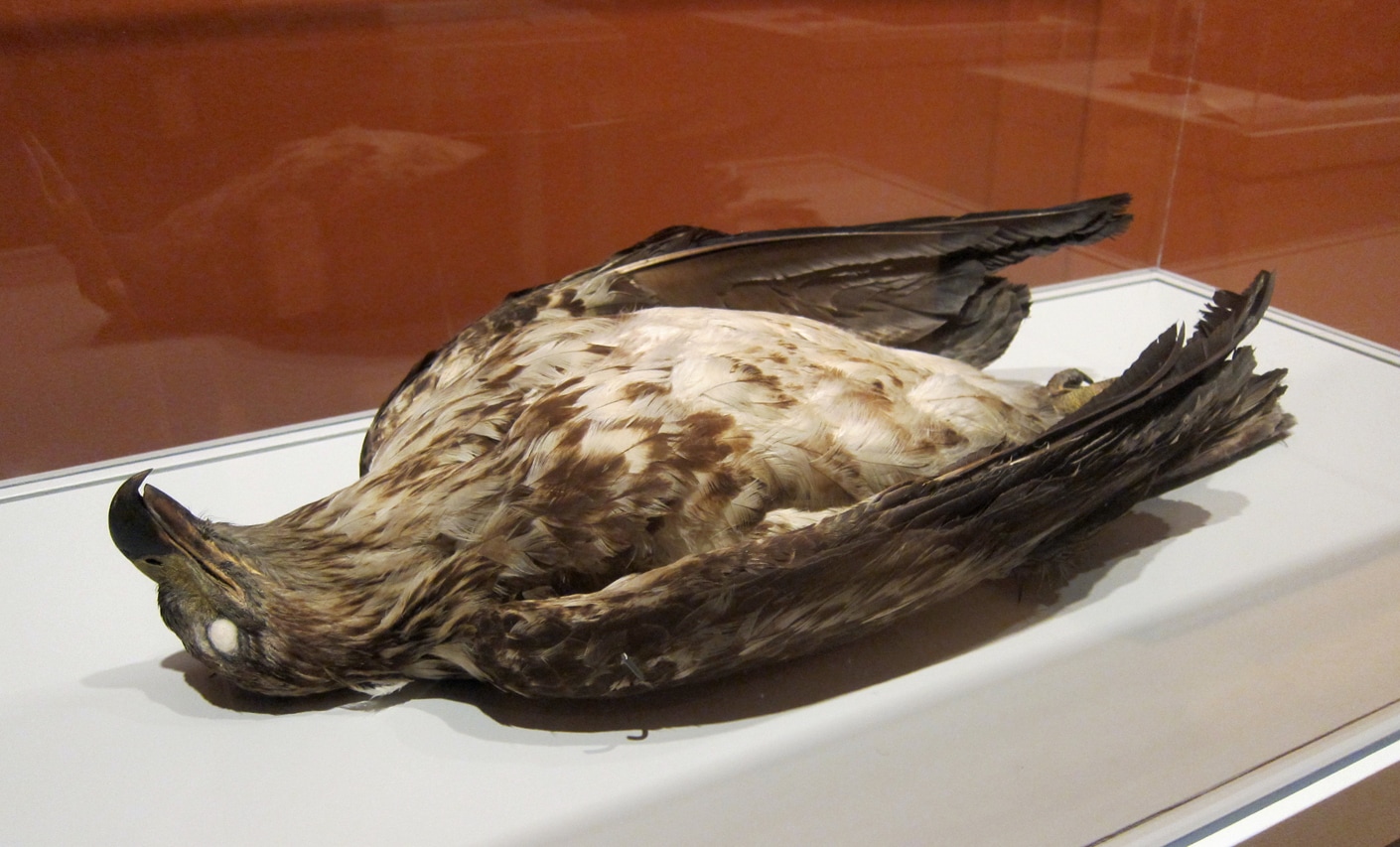
The second section, “Speculative Temporalities,” “conjures dream time, nonlinear and parallel realities,” in the words of the exhibition program. In a particularly powerful Nam Jun Paik TV piece, a camera focuses on a copy of Rodin’s Thinker and projects the image of the sculpture on a TV monitor, along with the images of any passersby. Afterwards, when I looked through my photographs, I found my smiling and somewhat startled face captured in the artwork.
The third section, “Mobility and Exchange,” presents landscapes and frontiers. Especially striking to me are renowned Life Magazine photographer Eugene Smith’s Rust Belt images from 1955, one of them a dark shot of a factory, its eleven smokestacks filling the air with thick smoke.
Kouoh does not proceed chronologically; instead she brings pieces together in often jarring juxtaposition. On one wall, she installed a trilogy of images of powerful women, placed side-by-side to create a conversation “on imperialism”: There is a fragment of an Egyptian relief sculpture from the fourth century BCE; there’s Queen Elizabeth II’s Coronation Portrait (1953) by English society photographer Cecil Beaton, the Queen regal and proper; and an oil painting by Beauford Delaney of the Pittsburgh philanthropist Tillie S. Speyer (1968). Against a background of washed-out pink, and sitting on what looks like a living room chair, Speyer wears a modest, green dress.
When Kouoh turned her curatorial focus to Pittsburgh, she juxtaposed the photojournalism of Eugene Smith with that of Charles Teenie Harris, a local photographer whose work for The Pittsburgh Courier, an African-American newspaper, captured with great pride the lives of African Americans in the City: family celebrations, achievements in the community, intimate evenings in the jazz clubs of the Hill District. Harris has his own special gallery in the CMOA, a narrow corridor by the admission desk featuring rotating thematic exhibits, but exhibiting his work side-by-side with Smith lends even more dimension to both. “It is a conversation that the museum has never brought together before,” Kouoh said.
Schaffner herself grew up in Pittsburgh, living there until she was ten, spending hours in the contiguous space that flowed from the art museum to the natural history museum to the library. For the exhibition, she was determined to find a way to connect those same spaces through art, and to pay homage to Pittsburgh. She commissioned a work by the Southwestern art collective Postcommodity, an enormous installation of steel, coal and glass, materials famously used by the city’s industries, which have been organized to look like rivers and sandbanks. The artists were inspired by the sand paintings of indigenous peoples. Viewed from the second-floor balcony above, it’s an impressive, abstract work that yet evokes the power of rivers, of which Pittsburgh has three. Schaffner, speaking from that vantage, says it “echoes Pittsburgh’s rivers by the force of lines.” Although abstract, the work has a commanding realism. The river bed is stark, black coal, surrounded by a field of crushed white glass, resembling sand. The rusted steel plates and pieces are sculptural reminders of the city’s industrial past.
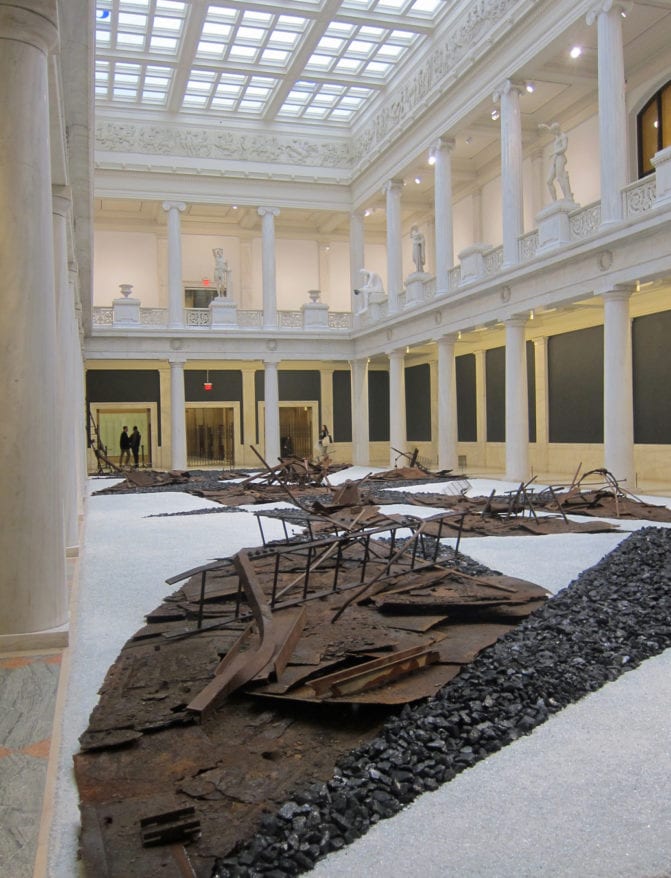
Weaving Pittsburgh into the fabric of the Carnegie International has historically been a challenge. In a significant nod to a local artist, Schaffner installed works by the African-American Pittsburgh sculptor Thaddeus Mosley, age 92, inside and outside the main lobby of the museum. They are abstract monoliths carved from walnut and varying in size from two to ten feet high. Mosley builds his work mostly by hand, with mallet and chisel, taking his inspiration from the nature of the walnut wood itself, variations in its color. His pieces capture the natural, organic vibrancy of the material. Some of the pieces are from a single tree while others have multiple parts. They are massive and graceful, round and angular, with some showing the influence of traditional African sculpture.
Mosley is a University of Pittsburgh graduate, and remembers the Carnegie International exhibitions from his college days; how he and his artist friends “would always look for how many Pittsburghers there were in the show.” He recalls that there were often two or three local artists, but sometimes, he said, “there were none.”
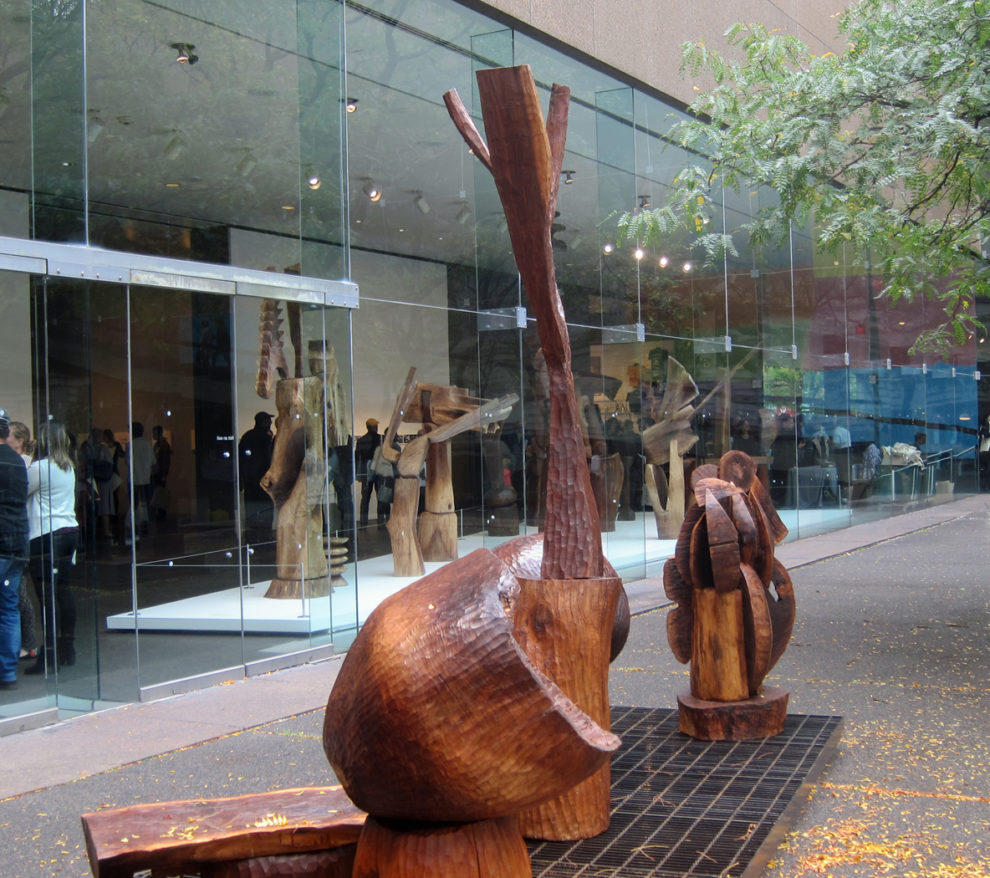
Across from the Mosley sculptures, a gallery has been turned into a studio by Lenka Clayton and Jon Rubin, both Pittsburgh artists. Fruit and Other Things focuses on what might have been. In the archives, they found ledgers containing lists of 10, 632 works that were rejected during the exhibition’s first 35 years, the only span for which the data was available. Drawing upon these archives, local artists were hired to sit in the gallery and paint the titles of individual works on paper for visitors to see and take home.
When the International opened on October 13th, these artists began painting titles of works in alphabetical order. My take-away: A Colonial Homestead by Mathilde Julie Morrow (later Julie Morrow DeForest 1881-1979), a painter of brightly colored Impressionist landscapes. Although the work was rejected in 1927, a little research reveals that Morrow, who lived in Ohio and in California, was successful in her later career, with several solo shows and group exhibits at the Corcoran Art Gallery, Brooklyn Museum, and the New York World’s Fair.
But we are left with no idea what A Colonial Homestead looked like. Only a ledger entry.
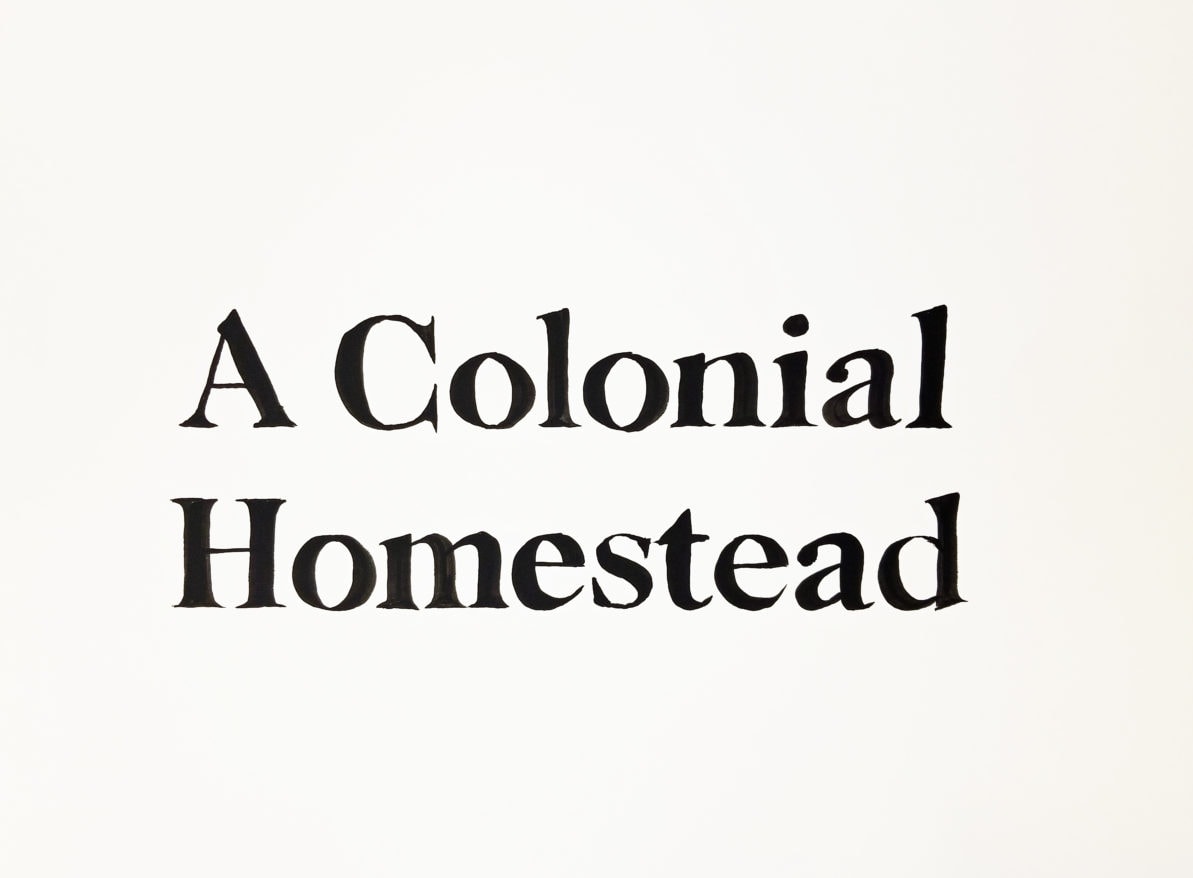
by the Museum. Photograph by Shael Shapiro.
Perhaps the most pointed integration of the new with the old is an installation by Tavares Strachan. On the frieze running around the old museum building, between the names of classical heroes like Shakespeare, Beethoven, and Newton, Strachan placed the names in neon of a new list of heroes including Tupac Shakur; Matthew Alexander Henson, the first African American Arctic explorer; Qiu Jin, the Chinese revolutionary and feminist; and Harriet Powers, a Georgia quilter born in slavery.
Pink, yellow, white, and blue neon colors shine in the night air. It is a bold remake of history. A message to all that the Carnegie Museum, like the world around it, is evolving.

